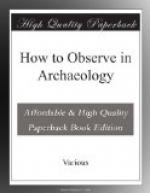Stone implements: as in Greece, including obsidian of very clear texture, probably of inner Asiatic, not Aegean production. Bone needles and other implements.
Pottery. Four varieties have been observed: (1) buff ground with simple linear decoration applied direct on the gritty body-clay in lustreless pigments, black, chocolate-brown, or red, according to the firing; (2) greenish-buff face, hand-polished, with polychrome varnish decoration of vandykes and other geometric motives; (3) monochrome, black to grey, not burnished, but sometimes decorated with incised linear patterns; (4) plain red or buff (e.g. large urns in which Neolithic burials were found on the Carchemish citadel). All pottery hand-made.
Figurines: rude clay and stone figurines are likely to occur, but have as yet been found very rarely in Neolithic strata.
Copper implements:
traces observed at Carchemish: to be looked for.
II. Bronze Age (Early Hittite).
(a) Early period to about 1500 B.C. Cist-graves made of rough stone slabs, near crude brick houses. Conjunction of such slabs with bricks would be an indication of an early Bronze Age site. Rare pot-burials survive.
Implements. Spear-heads of long tapering form rounded sharply at the base which has long tang (IX, Fig. 5): poker-like butts (IX, Fig. 2): knives with curved tangs: ‘toggle’ pins: all bronze (but a silver toggle-pin has been found) (IX, Figs. 1,8).
Pottery. All wheel-made but rough: light red or buff faced of reddish clay: decoration rare and only in simple zigzags or waves in reddish-brown pigment: long-stemmed vases of ‘champagne-glass’ form are common (VIII, Fig. 4): rarely a creamy slip is applied to the red clay.
(b) Later period. Cist-graves apart from houses, in cemeteries.
Implements. Long narrow celts often riveted: spear-heads, leaf-shaped or triangular (IX, Figs. 3, 6, 10): axe-heads with socket, swelling blade and curved cutting edge: pins both ‘toggle’ and unpierced, straight and bent over.
Pottery. Wheel-made, well potted, and commonly ring-burnished, the process beginning at the base of a vase and climbing spirally: little painted decoration: face usually dusky brown over pinkish body clay, but red and yellow-white faced wares also found: shapes, mostly bowls, open and half closed: ring feet, but no handles to vases: only occasionally lug-ears (IX, Figs. 1,2,3,5,6). Rims well turned over belong to the latest period, in which elaborate ring-burnishing is common.
Beads, &c. Diamond-shaped, with incised decoration, in clay or stone, common. Pendants, &c., of shell, lapis lazuli, cornelian, crystal. Cylinders, of rude design like Babylonian First Dynasty, in stone and bone. Spindle-whorls in steatite and clay.
[Illustration VIII: Syrian pottery]




